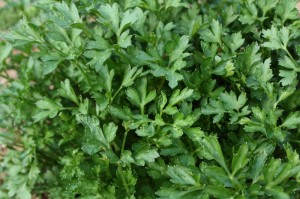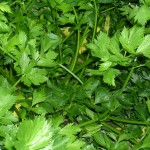One herb that grows easily in our climate is parsley (Petroselinium crispum). Whether you’re growing the flat leafed Italian varieties or curly leafed parsley, they thrive during periods of cool weather but also survive the heat of summer. This biennial (flowers the second year of growth) usually dies in winter, but I’ve dug them up in fall, potted the plants and brought them indoors to enjoy for another few months before they stop growing.
Parsley is not just a dark green garnish. The leaves are high in vitamins and minerals. I use parsley in soups, salads, and to make a scrumptious green shake of parsley, bananas, maple syrup and water. Yumm. Parsley is also a good edible landscape plant. This low growing herb makes a good dark green edging for annual annual and perennial flower gardens.
When to Plant
Plant parsley seeds or transplants directly in the garden after all danger of frost has passed. Like its cousin the carrot, parsley seeds are notoriously slow to germinate. If you’re growing just a few plants, it’s easier to buy them locally. For larger planting, start seeds indoor 6 weeks before your last frost date to grow a seedling that will be transplanted into the garden or a container later.
Where to Plant
Parsley grows best in full sun on well-drained, compost amended soil. If you have clay soil, consider growing parsley in an 8-inch tall raised bed. Parsley makes a great container, window box, or hanging basket plant as well. Plant parsley along walkways with your flowers or near the kitchen to be readily accessible when cooking.
How to Plant
Amend the soil with compost and space seedlings 12 inches apart in rows spaced 12 inches apart. If sowing seeds, thin the seedlings to the proper spacing when they’re 2 inches tall. Since germination can take up to 3 weeks, keep the bed well watered. Consider covering the bed with a floating row cover to help keep it moist.
Care and Maintenance
Parsley likes a rich soil so add a small handful of an organic fertilizer, such as 5-5-5, monthly around each plant. Keep plants well watered and mulch after weeding with straw or untreated grass clippings to help keep the soil cool and moist and to keep soil out of the crevices of curly parsley’s leaves.
Control for aphids with sprays in insecticidal soap. Swallowtail butterfly larvae love to feed on parsley. It’s actually a great plant to grow in a butterfly garden for that reason. Unless there are many caterpillars on your plant, don’t worry about controlling them. A few won’t cause too much damage. Handpick and move those that are devouring a plant.
Harvest
Harvest parsley starting about 1 month after planting, removing the outer leaves first and snipping the leaf stem to the plant crown. By snipping the outer leaves, it allows the inner leaves to continue to grow. Harvest as needed during the summer. In fall before a hard frost, dig up plants in the ground and pot them. Place the pots in a shaded, protected area outdoors for 1 week. Gradually move it indoors into a sunny window. It will continue producing leaves until the light levels diminish in fall. Then harvest what’s left and compost the plant.
Additional Information
‘Moss Curled’ and ‘Forest Green’ are two curly leaf varieties with good flavor and yields. ‘Italian Flat Leaf’ and ‘Giant of Italy’ are tall, big leafed varieties good for soups and cooking. ‘Par-cell’ is like a cross between celery and parsley. It has a sweet celery flavor, but grows more like parsley plant.
Text excepted from the Northeast Vegetable and Fruit Gardening book.




